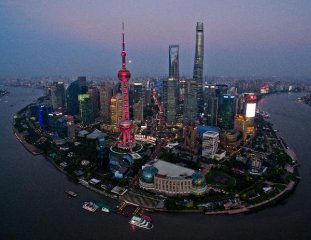China’s commercial real estate investment rose to a record 296 billion yuan (US$44.08 billion) in 2018, as the gap left by cash-strapped local investors was closed by overseas investors who jumped on acquisition opportunities, according to real estate service firm Cushman & Wakefield.

The 9.5 per cent rise in commercial property investment from a year earlier - a slowdown from 30 per cent surge in 2017 - comes against a backdrop of international trade frictions, a regulatory clampdown on lending, and a cooling domestic economy.
The credit squeeze weighed negatively on Chinese developers and real estate funds, whose share of total investment retreated to 68 per cent in 2018 from 80 per cent a year earlier.
However, foreign investment rose to 94.6 billion yuan, or 32 per cent of the total, more than double the amount in 2017, according to Cushman & Wakefield.
“Prevailing trade frictions and ongoing economic cooling did little to quench foreign investors’ appetite for property in mainland China,” said Catherine Chen, head of forecasting and capital markets research Greater China at Cushman & Wakefield.
Foreign capital showed a clear preference for China’s first-tier cities, accounting for 45 per cent of total commercial property investment in Beijing, Shanghai, Shenzhen and Guangzhou, up from 25 per cent in 2017. Shanghai was the primary target of foreign capital, accounting for 61 per cent of the total investment in the city’s commercial sector. The foreign investment figure represented a jump of 78 per cent from a year earlier.
“Overseas investors are always looking at opportunities in China, but in the past they were always outbid by deep-pocketed Chinese buyers. They were held back by their global investment metrics under which Chinese assets look pricey,” said Gary Wen, head of commercial department at Savills North China. “But the situation has changed.”
Reeling from the year-long government clampdown on excessive debt, cash-strapped developers have shifted gears and restructure project pipelines to focus on residential developments. Many local players backed away from commercial development or even looked to dispose of commercial project companies to shore up their balance sheets, such as the debt-laden HNA Group and Oceanwide Holdings.
Cushman & Wakefield, as well as other major real estate service institutions in China, expect the strong momentum to continue this year. As more vendors put their assets on sale, they favour “offshore” structures, which include embedded lower-cost offshore debt.
“The international players will continue to take advantage of tighter liquidity in China’s property market in 2019 as they execute strategic goals of raising exposure in one of the world’s largest economies,” said Gordon Marsden, regional director of Cushman Capital Markets Asia-Pacific.
Among all the foreign-originated deals in 2018, the biggest was by Singaporean groups CapitaLand and GIC, which bought Star Harbour in Shanghai for 19.8 billion yuan. Other high-profile deals include Gaw Capital’s disposal of Pacific Century Place in Beijing to China Visionary for 10.5 billion yuan, and Blackstone’s purchase of Mapletree Vivo City in Shanghai.
But Chinese investors remain a dominant force, even as the credit squeeze has forced some retrenchment. Among lower-tier cities, Chinese developers are responsible for a majority of new projects. At a recent high-profile land auction, a consortium led by China Resources Land and Citic Group outbid Hong Kong property developers to snap up a plot in central Shanghai.
“Even as Chinese investors weaken, the recent foreign-involved deals remain expensive. There is no such thing as bottom fishing. But given the scarcity of prime land in the biggest Chinese cities, the current price will be considered bargains several years later,” said Wen.

The 9.5 per cent rise in commercial property investment from a year earlier - a slowdown from 30 per cent surge in 2017 - comes against a backdrop of international trade frictions, a regulatory clampdown on lending, and a cooling domestic economy.
The credit squeeze weighed negatively on Chinese developers and real estate funds, whose share of total investment retreated to 68 per cent in 2018 from 80 per cent a year earlier.
However, foreign investment rose to 94.6 billion yuan, or 32 per cent of the total, more than double the amount in 2017, according to Cushman & Wakefield.
“Prevailing trade frictions and ongoing economic cooling did little to quench foreign investors’ appetite for property in mainland China,” said Catherine Chen, head of forecasting and capital markets research Greater China at Cushman & Wakefield.
Foreign capital showed a clear preference for China’s first-tier cities, accounting for 45 per cent of total commercial property investment in Beijing, Shanghai, Shenzhen and Guangzhou, up from 25 per cent in 2017. Shanghai was the primary target of foreign capital, accounting for 61 per cent of the total investment in the city’s commercial sector. The foreign investment figure represented a jump of 78 per cent from a year earlier.
“Overseas investors are always looking at opportunities in China, but in the past they were always outbid by deep-pocketed Chinese buyers. They were held back by their global investment metrics under which Chinese assets look pricey,” said Gary Wen, head of commercial department at Savills North China. “But the situation has changed.”
Reeling from the year-long government clampdown on excessive debt, cash-strapped developers have shifted gears and restructure project pipelines to focus on residential developments. Many local players backed away from commercial development or even looked to dispose of commercial project companies to shore up their balance sheets, such as the debt-laden HNA Group and Oceanwide Holdings.
Cushman & Wakefield, as well as other major real estate service institutions in China, expect the strong momentum to continue this year. As more vendors put their assets on sale, they favour “offshore” structures, which include embedded lower-cost offshore debt.
“The international players will continue to take advantage of tighter liquidity in China’s property market in 2019 as they execute strategic goals of raising exposure in one of the world’s largest economies,” said Gordon Marsden, regional director of Cushman Capital Markets Asia-Pacific.
Among all the foreign-originated deals in 2018, the biggest was by Singaporean groups CapitaLand and GIC, which bought Star Harbour in Shanghai for 19.8 billion yuan. Other high-profile deals include Gaw Capital’s disposal of Pacific Century Place in Beijing to China Visionary for 10.5 billion yuan, and Blackstone’s purchase of Mapletree Vivo City in Shanghai.
But Chinese investors remain a dominant force, even as the credit squeeze has forced some retrenchment. Among lower-tier cities, Chinese developers are responsible for a majority of new projects. At a recent high-profile land auction, a consortium led by China Resources Land and Citic Group outbid Hong Kong property developers to snap up a plot in central Shanghai.
“Even as Chinese investors weaken, the recent foreign-involved deals remain expensive. There is no such thing as bottom fishing. But given the scarcity of prime land in the biggest Chinese cities, the current price will be considered bargains several years later,” said Wen.























Latest comments